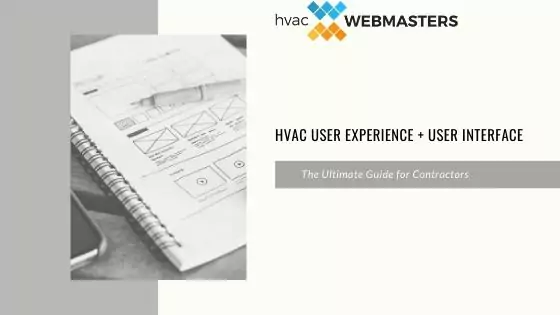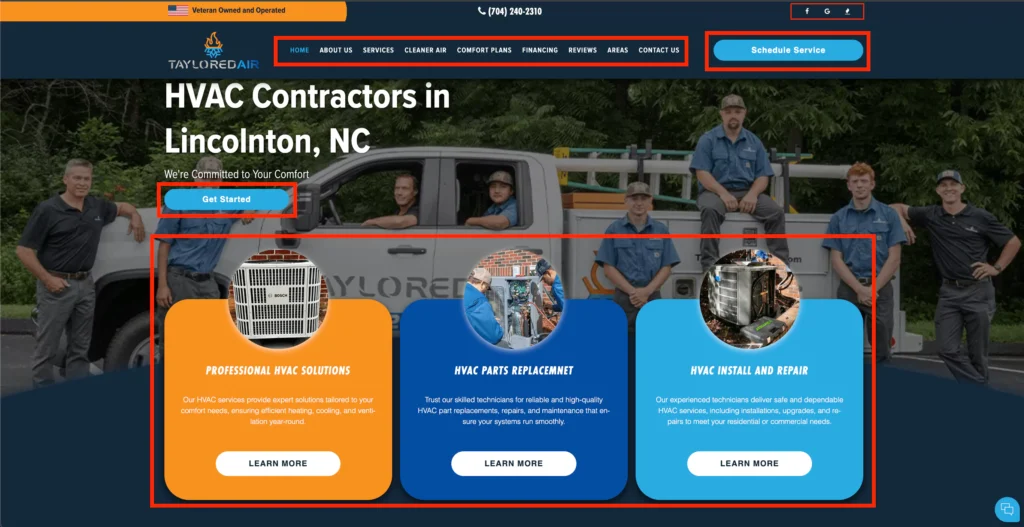What is User Experience for HVAC Websites?
User Experience or UX is the ease with which visitors interact with your HVAC website, including navigation, information, and efficiency.
The goal of UX is to meet the user’s needs and encourage them to take decisive action on your website. Furthermore, UX influences behavioral metrics such as dwell time, time on site, bounce rate, and others.
In totality, these metrics reflect the usability of your website to search engines.
What is User Interface for HVAC Websites?
User Interface or UI is the presentation and appearance of your HVAC website, including its design, theme, and general design framework.
UI contributes to UX because well-crafted interfaces enhance the user’s overall experience. In addition, UI contributes to a website sales funnel by helping users seamlessly complete a call-to-action.

The Influence of UX & UI on HVAC Consumers
Have you ever visited a website and become frustrated because it was challenging to navigate or because you couldn’t find the information?
Conversely, when you were on a website, everything you came for was available with just a few clicks.
These interactions are examples of User Experience and User Interface (UX and UI): the former being a bad example and the latter being a good example.
UX and UI are closely related to website design, which may be a subject outside your experience as an HVAC tech or contractor.
However, they are vital to your company’s success because they are closely related to marketing and lead generation.
This guide details HVAC user experience and interface to help companies maximize their digital presence.

Differentiating UX and UI
On the surface, the user interface and user experience look similar. They are very closely related; however, knowing the difference is essential.
UI is a subset of UX. UX considers how a person feels when on your website, while UI deals with the more specialized technical aspects of how the user interacts with the website.
You can think of it in these terms: UI is relegated to technical aspects, while UX deals with complex technical and human aspects of website design and function.
What Goes Into Good UX and UI?
Again, you may not have much in-depth knowledge of UX and UI design, but you should know what it takes to create a site that gives visitors what they want. The process of UX and UI design should include:
Planning
Whether you are tackling UX and UI yourself or working with a designer, it’s crucial to establish well-defined goals for your HVAC website.
You may offer HVAC services, and you may sell HVAC equipment. So your goal would be to promote your products and your services.
You may only provide HVAC services, in which case the purpose of your website would be to promote only your services.
You may have a blog intended to educate people on HVAC services, so you’ll want to get as many eyes as possible on your posts. Whatever the case, you have to be aware of your site’s goals.
Defining Personas
In UX design, a persona refers to the characteristics and behaviors of people likely to visit or use your website.
It’s essential to determine your persona as clearly as possible so you can design your website according to their technical proficiency and preferences.
For example, if your target market is middle-aged homeowners, you will want to create your UX around that persona.
Mapping
Now, it’s time to take your UX goals and personas and use them to create a map that will guide them toward action.
Mapping for an HVAC website may look like a homepage, service page, contact page, appointment page, etc. You will want to create a flow of clicks based on who is likely to use your site and their needs, goals, and behaviors.
Page Schematics
Once you have a map (or two) set up, it’s time to turn it into a visual schematic and project how users will experience the site.
You can use plenty of tools to create the page schematic of your website, but no matter which device you use, the goal remains the same: create a basic framework for your website that outlines how the visitor will navigate it.
Page schematics illustrate the layout of your website. The schematic should be created and closely scrutinized before actual development begins.
You must work out page sizes, content layout, and navigation elements at this stage.
Site Testing
Site testing can provide you with useful information before your website goes live.
You may not always have the luxury to test a prototype of your site with actual users before it goes live, but if you do, take advantage.
Site testing involves gathering a small group of users (personas) and taking into account their input as they navigate the basic prototype of your site.
Was it easy for them to see all the pages? Did they get the information they were after? Were they able to take specific actions? Was the site responsive?
A/B Testing
Your job continues once you have completed all the steps mentioned above and your site goes live.
Real-time testing should be conducted regularly, also known as A/B testing, and it can help you make quality HVAC user experience upgrades to your site.
A/B testing involves running your current site against a variant and seeing which performs better (which gets more clicks, more traffic, engages people for longer sessions, etc.).
A/B testing should run for at least seven days to get a good sample size and an idea of what can be improved.
Website Design for HVAC Companies
All in all, your UX design should be marketing-oriented. Your website should be the primary source of leads for your HVAC business.
Here at HVAC SEO Webmasters, we design websites that are not only focused on UX and UI but ones that also help you gain new customers.
When customers book your HVAC services, your website has achieved its goal, and your marketing budget provides a substantial ROI.





